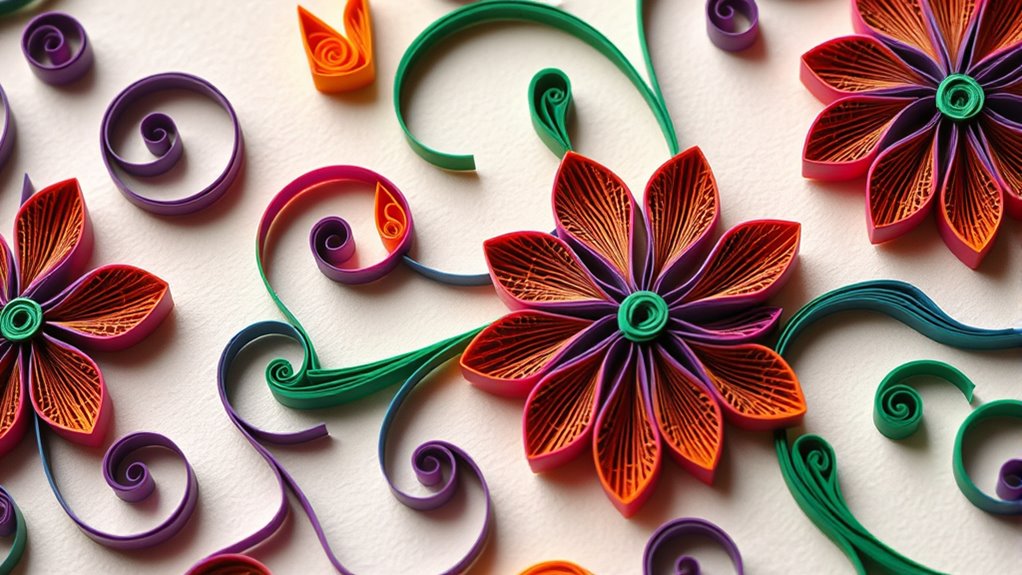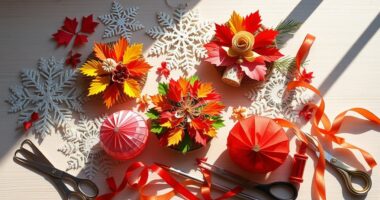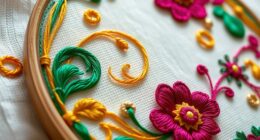Paper quilling transforms simple paper strips into intricate artworks using centuries-old techniques and modern innovations. You roll, shape, and glue strips to create detailed designs for jewelry, cards, or wall art. Over time, artisans have refined their methods, incorporating specialized tools and materials to push creative boundaries. This versatile craft merges tradition with contemporary styles, offering endless opportunities for artistic expression. Keep exploring, and you’ll discover even more ways to turn paper into stunning art.
Key Takeaways
- Paper quilling involves rolling, shaping, and gluing paper strips to create intricate, decorative designs.
- Traditional tools like needles and tweezers have evolved to include precision slotted tools and specialized glues.
- Artists combine various shapes such as scrolls and teardrops to develop layered, three-dimensional artwork.
- Modern techniques incorporate textured papers, metallic elements, and digital design for innovative effects.
- Quilling transforms simple paper into detailed art pieces, jewelry, greeting cards, and wall decor through creative layering and shaping.

Have you ever wondered how delicate, intricate designs are created from thin strips of paper? The art of paper quilling has a fascinating history that dates back centuries. Originally, it’s believed to have originated in 16th-century Europe, where nuns and monks would use quilling to decorate religious texts and ornate boxes. Over time, this craft spread across Europe, gaining popularity among aristocrats and artisans alike. During the Renaissance, quilling was considered a refined art form, often used to embellish jewelry, portraits, and decorative items. In the 18th and 19th centuries, quilling became more accessible to the middle class, with patterns growing more complex and detailed. Today, the history of quilling reflects a blend of tradition and innovation, with artists continuing to explore new styles and methods.
Modern quilling techniques have evolved notably from those early days. While traditional methods relied on simple tools like quilling needles and tweezers, contemporary artists incorporate a variety of tools and materials to enhance their work. For example, you might use precision slotted tools to create uniform coils or adopt specialized glues to secure delicate shapes. The introduction of different paper types, such as metallic or textured papers, allows for more vibrant and varied designs. Modern techniques also emphasize layering and combining different shapes—like scrolls, teardrops, and tight coils—to build complex, three-dimensional compositions. Some artists experiment with unconventional forms, such as combining quilling with painting, embroidery, or even digital design, pushing the boundaries of this traditional craft. Additionally, the rise of online tutorials and workshops has made learning quilling techniques more accessible to beginners and seasoned artists alike.
If you’re interested in trying quilling, it’s helpful to understand how these modern techniques can expand your creative possibilities. You can start by learning the basics—rolling, shaping, and gluing strips of paper—then gradually experiment with different shapes and textures. Tutorials and workshops often highlight the latest tools and methods, making it easier for you to develop your skills. Whether you want to create delicate jewelry accents, intricate greeting cards, or wall art, modern quilling techniques provide a versatile platform for artistic expression. The craft has grown from its historical roots into a dynamic art form that combines precision with creativity. By exploring both the history of quilling and embracing contemporary methods, you can see how this ancient craft continues to inspire and evolve, offering endless opportunities to transform simple paper into stunning works of art.
Frequently Asked Questions
What Types of Paper Are Best for Quilling Projects?
You should choose lightweight, smooth paper for quilling projects, as it’s easier to roll and shape. Look for paper with a consistent texture, avoiding rough or textured varieties that can be difficult to manipulate. When selecting paper, consider color options that complement your design, as vibrant or pastel shades can enhance your artwork. Thin, high-quality paper guarantees clean edges and better control, making your quilling creations more polished and professional.
How Long Does It Take to Master Basic Quilling Techniques?
You might find that mastering basic quilling techniques takes around a few weeks of consistent practice. As you practice, your skill development accelerates, and techniques become second nature. Coincidentally, the more you work with different paper types, the quicker you’ll improve. Dedicate a little time each day, and soon, you’ll find yourself creating beautiful designs effortlessly. Patience and regular technique practice truly make the difference in your quilling journey.
Are There Eco-Friendly or Recycled Paper Options for Quilling?
Yes, you can definitely find eco-friendly materials for quilling, like recycled paper and other sustainable options. Using recycled paper not only helps the environment but also adds unique textures and colors to your designs. Look for brands that specialize in eco-friendly materials, or repurpose old magazines, packaging, and scrap paper. Incorporating recycled paper into your quilling projects makes your art more sustainable and creative, all while reducing waste.
Can Children Safely Learn and Practice Paper Quilling?
Yes, children can safely learn and practice paper quilling with proper precautions. You should supervise them closely, especially with sharp tools like fine-tipped scissors or needles. Using age-appropriate tools designed for small hands makes the activity safer and more enjoyable. Starting with simple shapes and guiding their techniques helps develop skills gradually, ensuring safety and fostering creativity. With supervision and suitable tools, kids can delight in this artistic craft.
What Are Some Common Mistakes Beginners Should Avoid?
To avoid common pitfalls and beginner errors, you should carefully handle your paper strips to prevent tearing or uneven edges. Don’t rush when curling or shaping the paper; patience improves quality. Avoid overusing glue, which can cause messes or weaken your design. Practice with different widths and types of paper to learn what works best. Ultimately, follow tutorials closely and take your time to build skill gradually, ensuring a steady learning curve.
Conclusion
Now that you’ve explored paper quilling, you realize it’s more than just shaping paper – it’s an art form that captivates many. Did you know that the global paper quilling market is expected to grow at a compound annual rate of 6.5% over the next five years? As you continue practicing, you’ll discover endless creative possibilities. So pick up your paper and start transforming simple strips into stunning, intricate designs that showcase your unique style.








